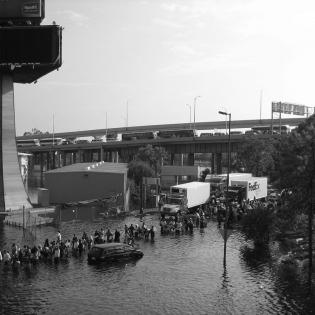Who Can Help? Sharing Makes Caring
This lesson introduces the learner to some of the resources--individual, organizational (for profit and non profit), and governmental-- available to provide forewarning/alert, preparedness programs, as well as relief during and in the aftermath of natural disasters.
The learner will:
- Identify a variety of natural disaster relief agencies and what they do.
- Identity the ways individual citizens can help during and in the after math of natural disasters.
- Explore the concept of shared humanity and how natural disasters provide citizens of the world opportunities to help those affected by natural disasters.
- Display Board
- Photo of a hand reaching out to another hand (Optional)
- Resource Books and/or Internet access
- Disaster Agencies (Attachment One)
- Disaster Agency Checklist (Attachment Two)
- For Related Units and Lessons see also www.learningtogive.org
Instructions
Teacher Note: Before this lesson, locate a photo--or identify a student “artist” in your class to draw two hands reaching out to each other and place this photo/drawing on the display board.
Anticipatory Set:
Challenge the learners to identify your purpose for placing this photo/drawing on the board. Explain to them that you are hoping to show “someone reaching out to someone else in an effort to be of help to them”. Share with the class that in times of natural disasters people, civil society organizations, and governments typically reach out to help those victims of the disaster. Review with the class the many ways that victims of natural disasters can be helped by individuals, organizations, and governments. (Encourage them to think back to the work they did in Lessons One and Two as well as reflect on things that they read or heard about.) As they are providing these ideas, write them on the display board around the “helping hands”.
Once the listing is sufficiently completed, go back over each listed item and have the learners tell you if the “help” is something that might more appropriately be offered by an individual (I), a civil society organization (O), or the government (G) and place the appropriate letter or letters next to each item.
Have the learners draw conclusions from this exercise leading them to conclude that no one has sole responsibility for helping, but that everyone needs to help.
Encourage the learners to share their written reflections to the prompt in Lesson Two; “The most important role the citizens of a community can play in natural disasters, occurs in the aftermath of the disaster.” Following this sharing session and subsequent discussion, pose this question to the class, “If this statement is true, what are some of the ways that you as an individual citizen could become involved in helping in the aftermath of a disaster?”
Remind the learners that it is no one person or group of persons responsibility to forewarn/alert, provide preparedness programs, and/or follow up with help in the aftermath of a natural disaster. In addition to what they might do as individuals or small citizen groups, agencies including regional, national, and international also provide these services.
Ask the class to identify as many of these other agencies as they can and list these agencies on the display board.
Distribute a copy of the Disaster Agencies (Attachment One) to each learner and group the class into pairs of two. Assign each group to research one of Disaster Agencies listed on this attachment and fill in the Disaster Agency Checklist (Attachment Two).
Conclude this class by having each group report their findings concerning their assigned Disaster Agency Checklist (Attachment Two) and discuss the similarities and differences among these agencies.
Place the term shared humanity on the display board and have the learners discuss how we all have basic needs that need to be met in order for us to live and it is this understanding that leads someone to care for some else whose basic needs are not being met.
Have the learners respond in writing to this prompt, “Why might people and agencies respond to natural disasters that occur in areas/countries other than their own, and perhaps even in areas/countries were personal/political relationships are strained?”
The learners’ involvement in the classroom discussions, the depth of their thinking and reflections, their completeness of their research and the effectiveness of their presentation, as well as the comprehensiveness of their journal responses, form the basis for the evaluation of this lesson.
Philanthropy Framework
-
Strand PHIL.II Philanthropy and Civil Society
-
Standard PCS 04. Philanthropy and Geography
-
Benchmark HS.2 Identify and describe how civil society sector organizations help people nationally and internationally.
-
Benchmark HS.3 Identify and describe civil society sector organizations whose purpose is associated with issues relating to "human characteristics of place" nationally and internationally.
-
-
-
Strand PHIL.III Philanthropy and the Individual
-
Standard PI 01. Reasons for Individual Philanthropy
-
Benchmark HS.1 Define and give examples of motivations for giving and serving.
-
Benchmark HS.4 Cite historical examples of citizen actions that affected the common good.
-
-
-
Strand PHIL.IV Volunteering and Service
-
Standard VS 01. Needs Assessment
-
Benchmark HS.1 Identify a need in the school, local community, state, nation, or world.
-
Benchmark HS.2 Research the need in the school, neighborhood, local community, state, nation, or world.
-
-
Standard VS 02. Service and Learning
-
Benchmark HS.1 Select a service project based on interests, abilities, and research.
-
-
Standard VS 03. Providing Service
-
Benchmark HS.1 Provide a needed service.
-
-
Standard VS 04. Raising Private Resources
-
Benchmark HS.3 Describe a detailed action for service.
-
-
Standard VS 05. Integrating the Service Experience into Learning
-
Benchmark HS.3 Identify outcomes from the service.
-
-
